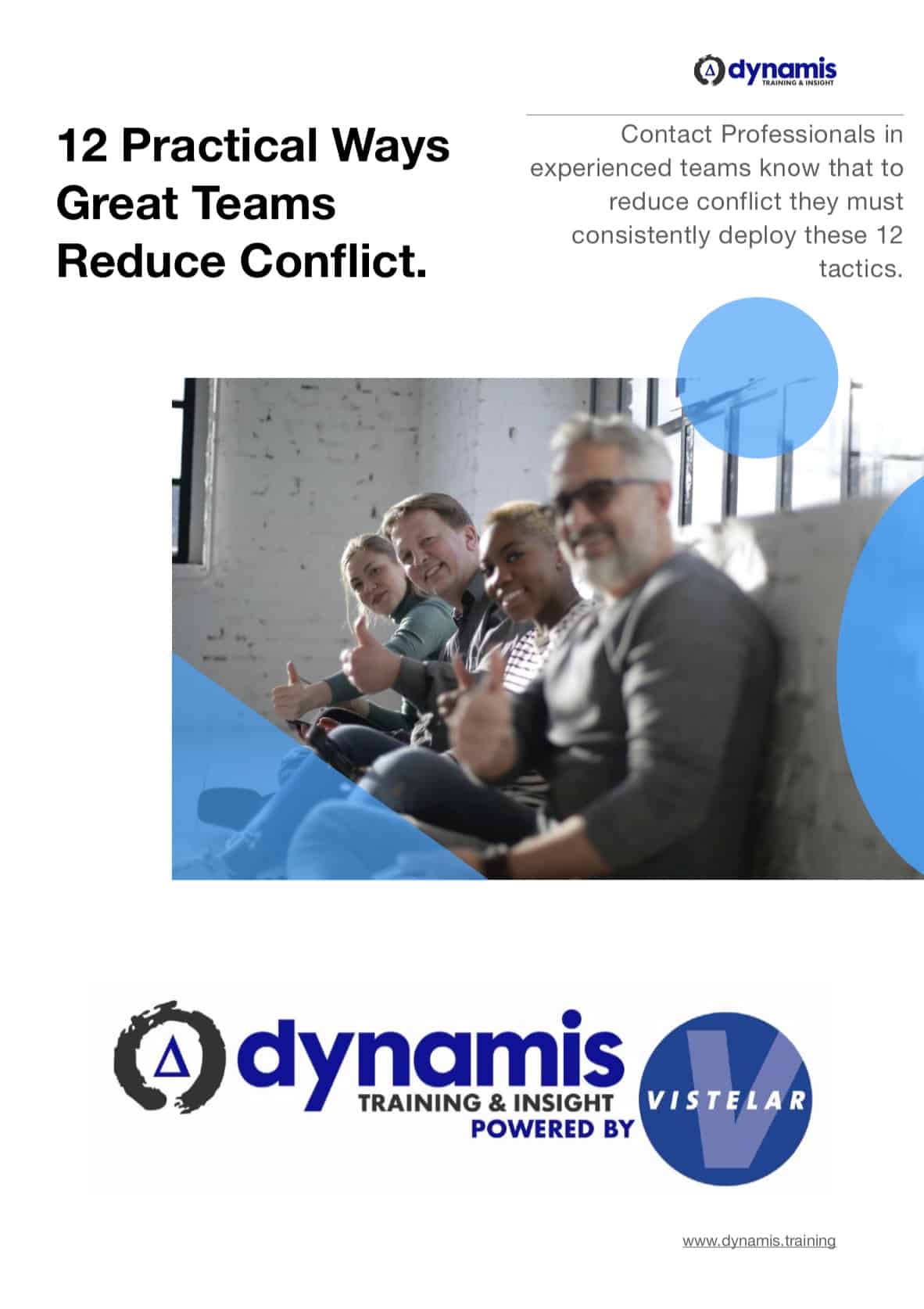Threat Detection in Personal Safety Training
by Zeb Glover in conversation with Ger O’Dea – Dynamis Training
When we look at personal safety, people tend to put it into categories – the physical aspects and the non physical aspects.
We could break down the non-physical aspect of Personal Safety training into two parts.
- The ability to detect a danger or a threat (threat detection)
- The ability to prevent it from becoming physical.
We talk about the detect, the defuse and de escalation aspects of Personal Safety on our lone working course – we are doing all three aspects of this.
We give a whole rounded, experience, understanding and learning on all three areas. But, if we had to choose what the most important aspect would be, and what would be the easiest to learn, I’d say it’s the first one – detect.
The good news is, however many years people have been living their lives quite successfully before they come on our course, they observe human behaviour every single day. They might actually be quite good lit, but it is a bit hit and miss. We have to give some framework to it and empower it.
The main principle is to address a concept called baseline versus anomalies.
There’s quite a well known book on this called Left of Bang (https://www.amazon.co.uk/dp/B00L45NXF4).
I was fortunate enough to train with a specialist, who was part of U.S Military (R&D) around that topic. In fact, they spent millions of dollars on that topic and I was lucky enough to glean from this expert the key points which came out of that material and knowledge.
You can use it every single day and “baselines and anomalies” applies to many different things and not just Personal Safety.
“The Baseline is the norm and it is always relevant to the context”
I’ll share the Threat Detection story that I share often with our groups on Personal Safety training. (We do a lot of storytelling just because it’s tends to get the point across in a more powerful way.)
I talk about the Tsunami that hit Japan in 2011, which occurred after a huge earthquake. We talk about what happened that day in this tiny little village in East coast of Japan.
Basically when the big earthquake hit, As you probably know, earthquakes in Japan are very frequent – that’s part of their norm. That’s part of their baseline.
However, this huge earthquake – the biggest one they’ve had for years and years – this one was out of the norm. In this little village, they had alarms in the village and when the ground shook, the alarms went off, and people took cover until the earthquake had passed.
And of course they’re doing the normal activities after an earthquake such as clearing up the mess. However, this is where it gets a bit interesting – some time later, the Tsunami alarms went off, which are like the old fashioned WWII alarms, but they have different sounds.
The Great Big Obvious Anomaly
The (threat detection) problem being that, in all those generations of the village, no one had heard this particular alarm go off before. Now we have got this fundamental problem, which ties in with how we detect personal safety threats in lone working and personal safety and that is our number one enemy – to be in denial.
People observe human behaviour every day, but are we really conscious about interpersonal threats or not? The truth is it really is a bit hit and miss!
Anyways, the tsunami alarm went off, and a lot of people ignored it. And it gets more interesting when you look at what happened on the beach.
At this point I normally ask the group, “Do you believe that you could predict a tsunami is coming before you can physically see it if you were on that beach? Because, if you wait until you physically see it, you’ve got a time issue, of getting away from it and getting to somewhere safe.
This an action-reaction problem. Some people say, no, I don’t think we can predict a tsunami. Some people say yes, I think we can. And some people even have the answers as to yes you can and HOW – they are aware of the cues or indicators. So it gets interesting to explore what happened on that beach.
One of the indicators of the tsunami, is an anomaly to the baseline. The baseline is the norm, the pressure of water in the sea produces a high tide, low tide twice a day. That’s the norm.
However, when there’s a tsunami approaching, as you may well know, the tide goes really far out. The main difference is the speed. It goes out super quick. It went out so quick that the people observed fish flapping around on the beach. That’s how fast the water went out.
People had never seen that before. This huge anomaly happens right in front of them. You get these various reactions to that, where some people just ignored it.
Some people realised “that’s not right”. And incredibly, some people walked towards the fish, out of curiosity. And unfortunately, what they didn’t realize is they’re walking towards the threat.
Threat detection and interpersonal conflict
When teaching people to do interpersonal threat detection, or to work alone in safety, we talk of files and folders – if in our brains, in our head-computers, if we don’t have the correct files and folders, i.e the indicators of what threats look like, it’s going to slow us down.
When we work alone we are going to hesitate, we are going to be confused, we’re going to have huge denial hitting us and it’s going to be a difficult challenge getting through denial, and therefore quickly getting into action.
And that’s the good news – if you could fill these files and folders, with useful, quick to learn information. Once you’ve got that information in your file and folders, then when your computer does that hard drive search, the search is going to find cues and indicators and now it’s just an emotion which you have. Am I going to get to action? What am I going to choose to do now?
But here’s the other side of this threat detection story.
On that beach that day there was a UK student of geology. So she knew all about earthquakes, she’s got the files and folders in her head. She knows what the indicators of a tsunami are. And she knew when she was on that beach, when she saw all those fish and that the tide had gone right out… she knew that a tsunami was coming, even though she couldn’t see it.
And the amazing thing is, she went and saved lots of lives. She grabbed as many people off that beach as she could.
And that’s the difference, just quite simply – having that information. Threat detection for a tsunami is really quick and easy to learn, just put it in your files and folders for later. However, with human behavior, sometimes the threat detection files and folders we already have might be corrupted.
Though again we might expect a psychopath or some predator to look a certain way, or be a certain age or race or gender. And I’d call that, a corrupted file.
I share the Earthquake./Tsunami story with the group just to demonstrate the power of establishing a baseline, and what a baseline is in any given context – and then you can start being aware of the anomalies.
Learning to Spot Indicators in Threat Detection
There are general and specific indicators that you can share, that are, I would call, real threat indicators. Regardless of the context, we do a lot of video analysis of real situations. We get people to establish what the baseline is, and then just narrate and consciously spot the anomalies. And we can play those videos again and again, and just help people become more aware of what those anomalies are.
In conflict or violence threat detection, the connection between your subconscious brain and your conscious brain is really important pathway to safety. Intuition is trying to do that for you. It’s trying to make that connection. It’s giving you that feeling or that persistent thought or whatever in the way it communicates.
Our brain is amazing. It is taking in so many pieces of information every second. It can’t possibly share all of that information with you consciously, every single second. Otherwise, you’d be a mess. You just couldn’t process it. But when there is a significant threat, there will definitely be a powerful intuition signal sent.
But I think then you consciously need to ask, well is this a threat? And that’s another important point.
When you can become conscious of those threats, that’s what really combats denial and makes you better at threat detection.
It’s similar to when I was doing my advanced driving during part of my bodyguard, close protection training.
When you’re doing advanced driving you narrate all the hazards. that process of narration brings a subconscious observation. Because when you’re driving you are normally, hopefully, aware of those hazards but you aren’t conscious, necessarily – not when you drive and you think, “I can’t remember that journey for the last five minutes. I was an autopilot”.
That’s fine. But if you are in a situation where you work alone, where, you’re going to try and combat denial, you might need to outwardly narrate what you’re experiencing and have that open questioning, for example – what am I observing here? Why am I feeling this way?
And then if you’ve got those files and folders in your head, they will very quickly pop up in your search. Especially when you know those cues – hopefully they never occur. But if the people we train do have one of those really unlucky moments, they are rare. But again, that’s the other issue to this isn’t it? It doesn’t happen every day. The social worker, or parking enforcement officer or community nurse’s alertness might drop and they get a bit complacent when they work alone.
The Naive Debutante and the Complacent Veteran
Sometimes, we have to realise that human beings love learning the hard way.
And that’s why we have the whole health and safety executive nowadays! Many bad things happen and they may have been foreseeable, and so we are making this whole process more conscious now through regulation, enforcement action and the courts.
I use the seatbelt analogy sometimes. How many years did we drive cars before it became law that we had to wear a seatbelt? How many deaths did it take for us to realize that seatbelts saves lives?
These realisations come in hindsight, so for example with a new social worker – their threat detection history, their hindsight, is not good. They need foresight.
So that all ties in with the value, I think of threat detection training amongst the other topics that we cover on our lone working training course, which is giving people the ability to have the foresight rather than hindsight.
Because, sometimes hindsight is too late.
This conversation between Ger O’Dea and Zeb Glover at Dynamis happened on 19 February 2019, right after Zeb got back from a very successful training engagement with a large Local Authority in England, teaching a mix of Social Workers, Enforcement Officers and Community Workers who carry out Lone Working.



Comments are closed.